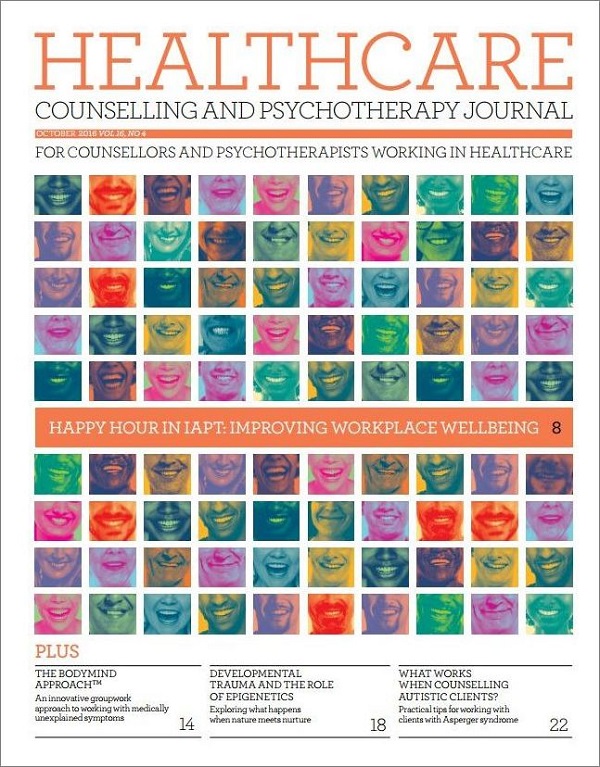In this issue
Features
Happy hour in IAPT: improving workplace wellbeing (free article)
Lowri Dowthwaite presents an innovative approach to supporting counsellor and psychotherapist wellbeing
The Bodymind ApproachTM to working with medically unexplained symptoms
Helen Payne outlines an innovative groupwork approach to working with medically unexplained symptoms
Developmental trauma and the role of epigenetics
Nikki Kiyimba explores the interaction between genes and environment in shaping human behaviour
What works when counselling autistic clients?
Elaine Nicholson provides practical advice on working with clients with Asperger syndrome
Regulars
Chair’s report – BACP Healthcare
Satinder Panesar
Healthcare update
Judy Stafford
Therapy in primary care
Elaine Davies
Third sector perspective
Michael Lilley

A pdf version of this issue is available from the Healthcare Counselling and Psychotherapy Journal archive
From the editor
This issue of the journal expands upon some of the excellent presentations that were made at the BACP Practitioners’ Conference back in April this year. It provides an opportunity for those of you who were unable to attend the conference to benefit from some of the really useful material that was presented – and for those of you who were there, it will hopefully be a timely reminder of some of the sessions you attended and an insight into those that you missed.
In our lead article, Lowri Dowthwaite writes about the importance of cultivating a culture of happiness and optimism within IAPT teams. Lowri was not present herself at the Practitioners’ Conference, but counsellor Angela West presented excerpts of Lowri’s work in her session on workplace wellbeing, and I was keen to find out more. We are all painfully aware of the difficulties faced when working in IAPT services, including the pressures of a target-driven culture, the stress of trying to provide adequate support despite short-term interventions, and anxieties about creating a ‘good enough’ holding environment for clients. Understandably, we focus a lot of attention and effort on these stresses. However, what we often neglect to do is to pay equal attention to building a culture of happiness, playfulness and gratitude, which would not only benefit us, but also our clients. Lowri’s innovative ‘Happy Hour’ project uses the principles of positive psychology to help IAPT staff to increase their happiness levels. Simple exercises, like keeping a gratitude diary, make a proven difference in team culture and individual wellbeing. This project seems to me to be one that could be successfully rolled out in IAPT teams throughout the country.
Another example of best practice that may be of relevance to mental health service providers throughout the UK is ‘The BodyMind Approach™’, which Helen Payne describes in her article. Many of us will have experience of clients presenting with unexplained physical symptoms, such as headaches, backache or insomnia, alongside anxiety and depression. These clients have often been in and out of doctors’ surgeries and hospitals, looking for the source of these physical problems, but to no avail. Helen shares her experience of setting up a group programme to address these issues. At the Medically Unexplained Symptoms (MUS) clinic, sufferers are offered the opportunity to participate in group sessions focusing on their physical symptoms, and allowing ‘the body to speak the mind’. Instead of talking therapy or discussion of the symptoms, patients are encouraged to move mindfully, paying close attention to their bodies and noticing the sensations that they feel.
The programme also makes use of breathing methods and dance movements. Anyone interested in this approach can contact the author for details of training opportunities.
One of the most fascinating presentations of the Practitioners’ Conference for me was Nikki Kiyimba’s talk about epigenetics. We are all aware of the ongoing debate about the respective roles of nature and nurture in terms of human behaviour. The new field of epigenetics sheds fresh light on this, as it demonstrates that our genes can actually be switched on or off by our environment. Nikki provides us with a straightforward overview of this complex field and explains how it is of relevance to the counselling and psychotherapy environment.
Many of us will have had clients in our counselling rooms who have been diagnosed with autism or Asperger syndrome. Sometimes the interventions and approaches that we might use with other clients can seem ineffective with this particular client group. Elaine Nicholson, who established the Action for Asperger’s charity, provides us with some helpful practical suggestions for working with clients with Asperger syndrome and explains why we might find ourselves failing miserably when we try to use some of our standard approaches. I, for one, will certainly be introducing some of her practical suggestions in my therapy room.
If you would like to share some of the innovative practices that you have developed in your service or organisation, please do not hesitate to contact me. We always welcome fresh ideas and best practice examples. I look forward very much to hearing from you.
Joanna Benfield
Editor hcpj.editorial@bacp.co.uk
